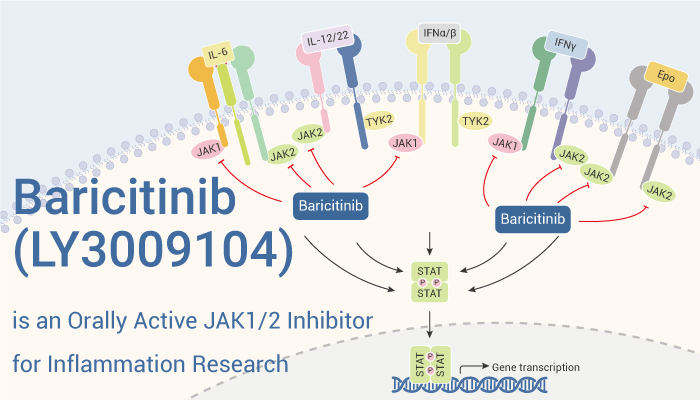Janus kinase (JAK) is a family of intracellular, non-receptor tyrosine kinases that transduce cytokine-mediated signals via the JAK-STAT pathway. Importantly, JAK1 and JAK2 are one of the human tyrosine kinase proteins essential for signaling for certain type I and type II cytokines. Particularly, Since members of the type I and type II cytokine receptor families possess no catalytic kinase activity, they rely on the JAK family of tyrosine kinases to phosphorylate and activate downstream proteins involved in their signal transduction pathways. Moreover, JAK signaling has been demonstrated to be dysregulated in metabolic diseases, including obesity and type 2 diabetes mellitus (T2DM). Besides, JAK2 deficiency in the liver, macrophages, or adipocytes protects against high-fat diet-induced metabolic inflammation. So, JAK2 may be a promising target for treating obesity, metabolic syndrome, and T2DM.

In this article, we will introduce a potent and orally active JAK1/2 inhibitor, Baricitinib.
Baricitinib is a potent and selective JAK1/2 inhibitor against JAK1, JAK2 and JAKs with IC50s of 5.9, 5.7, and> 400 nM, respectively. Moreover, Baricitinib (10 mg/kg died, p.o., 16 weeks) does not change the diet-induced alterations in the gut, but restores insulin signaling in the liver and skeletal muscle, resulting in improvements of diet-induced myosteatosis, mesangial expansion and associated proteinuria in a high-fat-high sugar diet (HD) mice.
Baricitinib (0-10000 nM) inhibits IL-6 stimulated phosphorylation of STAT3 (pSTAT3) and MCP-1 production in PBMCs with IC50 values of 44, 40 nM, respectively. Additionally, Baricitinib (0-10000 nM) inhibits pATAT3 stimulated by IL-23 in T-cells with an IC50 value of 20 nM. Meanwhile, Baricitinib (1, 3, 10 mg/kg; p.o.; daily for 2 weeks) inhibits disease scores by 24%, 57%, and 81% at 1, 3, 10 mg/kg in rats with established disease in the adjuvant arthritis model, respectively.
All in all, Baricitinib is a potent, selective, and orally active JAK1/2 inhibitor for inflammation research.
Reference:
[1] Collotta D, et al. Mol Metab. 2020 Sep;39:101009.
[2] Fridman JS, et al. J Immunol. 2010 May 1;184(9):5298-307.